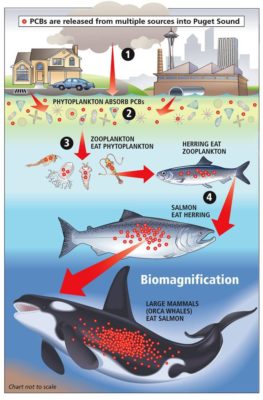Explain the Bioaccumulation and Biomagnicfacation and How They Are Different
Biomagnification occurs when a higher level predator eats a lower level organism and ingests the substance with it. In this activity you will identify the way in which DDT might move through a food chain.

Difference Between Bioaccumulation And Biomagnification Compare The Difference Between Similar Terms
Bioaccumulation is the process by which toxins enter the food web by building up in individual organisms while biomagnification is the process by which toxins are passed from one trophic level to the next and thereby increase in concentration within a food web.

. Biomagnification can be defined as the rise or increase in the contaminated substances caused by the intoxicating environment. The concentration of these toxic chemicals and pollutants seem to be very low when released in different environments it eventually. Explain why each of these are relevant to the energy discussion.
Respond to at least 3 others. First bioaccumulation affects one organism at a time whereas biomagnification affects many organisms. Even though the level at the lower levels of the food chain often referred as trophic levels may have very low concentrations as you move up the food chain the concentrations become higher and higher.
One may ask what harm can small concentrations of pollutants in the environment possibly do. Bioac - the toxicity of a single organism. The release of toxic chemicals and pollutants into the environments such as the seas air and land results in the accumulation of toxins and harmful substances in the environment.
Tertiary consumer such as seals the greater the concentration of DDT in their body as a result of a process called biomagnification. In essence biomagnification is a higher level biological process compared to bioaccumulation. Your first post is due Friday July 24 at 1130 pm and your responses will be due Sunday July 26 at 1130 pm.
Bioaccumulation and biomagnification are two different processes that often occur in tandem with one another. Explain the difference between bioaccumulation and biomagnification. B io Factsheet January 1998 Number 14 Bioaccumulation and Biomagnification Biodegradable substances are those which and genetic make-up.
Young larval forms tend to can be broken down by microbes into Definitions be much more sensitive than the adults of the same Bioaccumulation is the accumulation of species. Second biomagnification depends upon the dynamics of the food chain as the pollutant moves. Bioaccumulation refers to the gradual accumulation of substances such as pesticides or other chemicals in living organisms.
Bioaccumulation takes place in a single organism over the span of its life resulting in a higher concentration in older individuals. The contaminants might be heavy metals such as mercury arsenic and pesticides such as polychlorinated biphenyls and DDT. The answer will be a significant harm considering that the concentration of these pollutants increases as they make their way up the food chain eventually reaching a level where they can.
The food web biomagnification is defined as the trophic enrichment of contaminants within food webs and results in the preceding increase in chemical concentrations with. Biomagnification takes place as chemicals transfer from lower trophic levels to higher trophic levels within a food web resulting in a. Food chains are important interrelations among the organisms in the ecosystems.
The key difference between bioaccumulation and biomagnification is that bioaccumulation refers to the build-up of a toxic chemical in the body of a living organism while biomagnification is the increase of the concentration of a toxic chemical when going along a food chain. The internal dose is sometimes called biologically relevant dose and refers to the time-course of the chemicals concentration in the organism - that is what can cause toxic effects. The process by which a fat-soluble toxin builds up within the tissues of an organism.
Of the animal by a process called bioaccumulation. Biomagnification is a kind of condition in which the chemical concentration extends the concentration of its food in an organism when the major exposure path occurs from the diet of an organism. Biological magnification on the other hand refers to the concentration of a toxic chemical in the tissues of tolerant organisms at the successively higher levels in a food chain.
These substances are taken up by the organisms through the food they consume. Bioaccumulation and biotransformation are important processes because they regulate accumulation of chemicals along food chains and they determine the internal dose. The higher an animal is on the food chain eg.
Biomag - the increase of toxicity as toxin moves up the food chain the toxicity of a whole food chain.

Bioaccumulation And Biomagnification Increasingly Concentrated Problems Catalina Island Marine Institute

Bioaccumulation And Biomagnification Increasingly Concentrated Problems Catalina Island Marine Institute

What Is The Difference Between Bioaccumulation And Biomagnification Youtube
Comments
Post a Comment